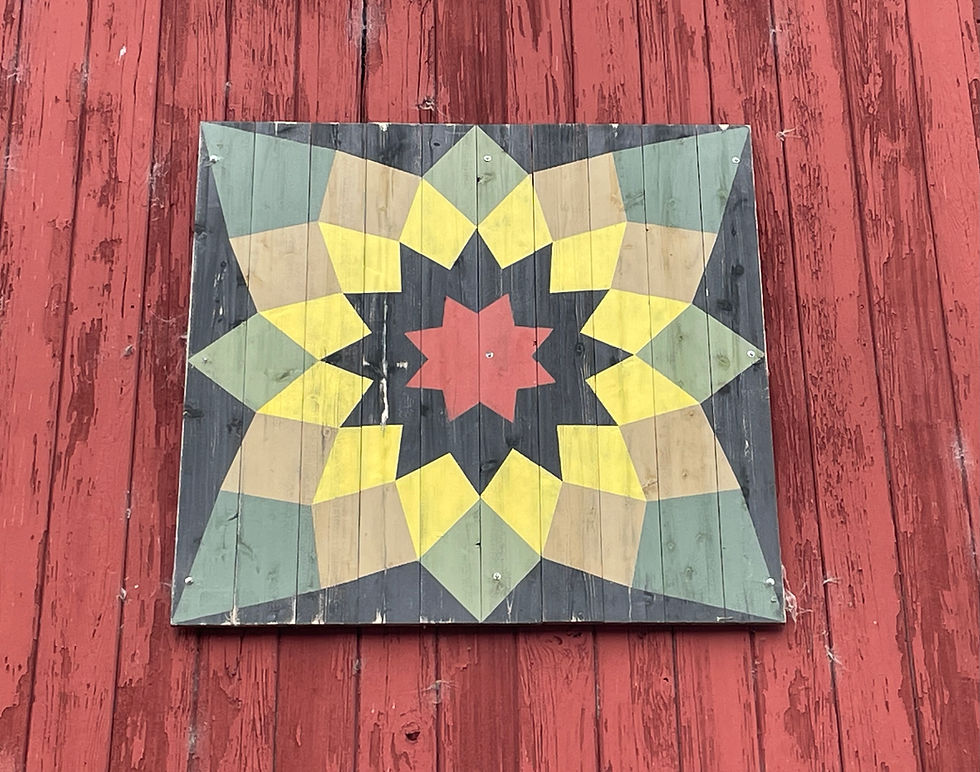Red Barn Quilt
- WarmQuilts
- Jul 31, 2025
- 3 min read
These colorful, American Folk Art quilt squares (measuring 4'x4' or 8'x8') can often be seen from a great distance when displayed on the road-side of a barn. We were fortunate to see the same two from a previous trip that I wrote about here, and we spotted a few others.

Our most recent trip had us returning to the same area, but visiting a different spot in the county known as Grizzly Bluff. Settled in 1853 and located in the Eel River Valley, we were six miles east of the Victorian Village of Ferndale, California.

The property had several red barns of various sizes situated very close to the road. We stopped when I spotted the barn quilt. I walked around the front of the buildings to see if there were other painted quilts . . .
None, but I spied an extra bonus; there was a selection of metal automotive and farming signs.
In the blog post by Lara Szypszak for the Library of Congress "A Closer Look", she shares Why Barns Are Red:
It turns out, the practice started in the late 18th century with New England farmers applying a protective varnish to barn surfaces. The varnish usually contained some mixture of linseed oil, lime, or iron oxide, which, under sun, would then turn to the red ochre hue that we have become so familiar with. Eventually, as red paint became available, many people stuck to the color tradition. It doesn't hurt that red paint is one of the cheapest colors available to purchase (this is because the large amount of iron and oxygen compounds in the paint are plentiful in the Earth)!
The red barn is certainly an iconic image. It's a long-standing practice in other parts of the world. Iron oxide was used from the mining tracts of Falun in Sweden. The color is still today called Faluröd. Although iron oxide has been used for thousands of years as a paint pigment, in Sweden it was apparently an attempt by the noblemen of the 16th century to mimic the brick and terracotta of European buildings.
Today, often a state or Arts Council will support a regional Quilt Trail. Many are community-driven, starting as a grassroots public arts movement. The Appalachian RC&D Council encourages you "to make your own quilt blocks as a way to connect with history, creativity and the beauty of the place that you call home." Here is the link to their DIY Guide if you'd like to make your own barn quilt.
"Take a trip back in time, slow down, and discover historic sites, produce stands, pick-your-own, local museums, art galleries, cafes, and other local flavors. It's fun in every season." ~Quilt Trail - Appalachian RC&D Council
From the Barn Quilt Info website: If you're looking for information about barn quilts and barn quilt trails around the US and Canada, then you're in the right place! At BarnQuiltInfo.com we love all things barn quilts, so pull up a chair, sit back, and soak in everything you can about our favorite works of art!
We didn't set out to search for barn quilts on this recent getaway, so it was a special treat to spot a familiar one and to find others along the way. I've been thinking that we might need our very own barn quilt - perhaps painted on metal. Do you have space for your own barn quilt?
Thank you for stopping by.
XOXOX






















I don't have an outside wall but a designer suggested I create a quilt to fill a large wall in the entry of our home. Still on the list.
Marcella - July 31, 2025
What a great piece of inspirational advice! I have seen a long, quilted, stained glass wall hanging in a tall stairwell and it was quite stunning.
WarmQuilts - Dec. 5, 2025